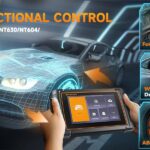For enthusiasts and owners of the iconic 95 Camaro, understanding its onboard diagnostic system is crucial for maintenance and performance tuning. A common question that arises is: Is A 95 Camaro Obd2? Let’s delve into the specifics of the 1995 Camaro’s diagnostic capabilities and what it means for you.
The 1995 Chevrolet Camaro, a part of the fourth generation (F-body), falls into a transitional period in automotive technology, particularly concerning On-Board Diagnostics (OBD) systems. OBD systems are essential for monitoring a vehicle’s engine and emissions systems, providing valuable data for mechanics and owners alike.
OBD1 vs. OBD2: Understanding the Difference
To answer the question definitively, the 1995 Camaro is not OBD2. It utilizes the OBD1 system. This distinction is significant because OBD1 and OBD2 are fundamentally different in their communication protocols, diagnostic capabilities, and connector types.
OBD1, the predecessor to OBD2, was less standardized. Different manufacturers often had proprietary connectors and diagnostic codes, making it more challenging to diagnose issues across various makes and models. In contrast, OBD2 brought standardization to the automotive industry. It mandated a universal diagnostic connector (SAE J1962), a standardized set of diagnostic trouble codes (DTCs), and enhanced diagnostic capabilities, particularly for emissions-related issues.
An OBD1 connector, like the one found in a 1995 Camaro, requires specialized tools and knowledge compared to the more standardized OBD2 system.
Why the Confusion About 95 Camaros and OBD2?
The confusion often stems from the fact that 1996 was the year OBD2 became mandatory in the United States for all new passenger vehicles. Vehicles manufactured in 1995, including the Camaro, predate this mandate and were equipped with OBD1 systems. While some 1995 model year vehicles from other manufacturers might have incorporated early OBD2 systems, the 95 Camaro remained firmly in the OBD1 camp.
Implications of a 95 Camaro Being OBD1
Knowing your 95 Camaro is OBD1 has several implications:
- Diagnostic Tools: You’ll need OBD1-specific diagnostic tools and scanners to read trouble codes and access vehicle data. OBD2 scanners will not be compatible with the OBD1 connector and protocol of a 1995 Camaro.
- Diagnostic Procedures: Troubleshooting and diagnosing issues on an OBD1 system can sometimes be more complex compared to OBD2 due to the lack of standardization and potentially less comprehensive diagnostic information.
- Tuning and Performance Modifications: While OBD1 systems can be tuned, the process and available software may differ from OBD2 tuning. However, experienced tuners are well-versed in working with OBD1 systems for performance enhancements.
The standardized OBD2 port is a universal feature in modern vehicles, simplifying diagnostics and access to vehicle data, but it is not present in a 1995 Camaro.
Considering an OBD2 Conversion for a 95 Camaro
Some owners of 94 and 95 Camaros consider converting to an OBD2 system. As hinted at in the original article, this is a complex undertaking. It’s not a simple plug-and-play process and involves significant modifications, including wiring changes and potentially PCM (Powertrain Control Module) replacement.
The benefits of an OBD2 conversion, as mentioned, often revolve around enhanced diagnostic capabilities, potentially faster processing speeds of later PCM versions (like a ’97 PCM), and greater tuning flexibility. However, it’s a project that demands a strong understanding of automotive electronics, wiring, and engine management systems. It’s definitely not recommended for those without substantial DIY automotive experience.
Conclusion
To definitively answer the initial question, a 1995 Camaro is OBD1, not OBD2. Understanding this is essential for proper diagnostics, maintenance, and any performance modifications. While OBD2 conversions are possible, they are complex and should only be undertaken by experienced individuals. For most owners, utilizing the OBD1 system with the correct tools and knowledge will suffice for maintaining and enjoying their classic 95 Camaro.
